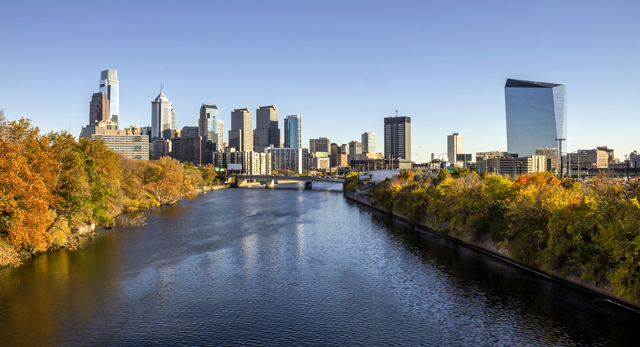Country Life Travel: Guide to Philadelphia
Clive Aslet visits Philadelphia, where America’s national identity was born

It's a joy to walk in Philadelphia is many wonderful things: a city of art, a city of green spaces, a city of fine restaurants. Like other cities, it went through a dark period in the 1980s, but is now a joy to walk in, with some of the handsomest museums in the USA displayed in a setting of grand urbanism. Much of this reflects the vision of 19th- and 20th-century improvers. The emergence as an industrial powerhouse, associated particularly with weaving, in the 19th century. But the Civil War history is stirring and, later, the city could rejoice in possessing the biggest urban park in the world: Fairmount Park, acquired to protect Philadelphia’s water supply, but landscaped as a place of resort for its people.
The best places to eat 13th Street buzzes with cosmopolitan restaurants, such as the gastro pub-like Barbuzzo. Amada, in Chestnut Street, provides a reprise on tapas and its location will be welcomed by visitors who are exhausted by the Old City.
The big misconception Every year, millions of visitors descend on Philadelphia to glory in the Liberty Bell and Benjamin Franklin. The Declaration of Independence was signed there in 1776. Such is the importance of old Philadelphia to the American consciousness that it’s actually an historical national park: an open air museum-cum-shrine. It has to be seen.
For me, however, the physical remains of America’s early capital city should be seen through the layers of hagiographical interpretation that started with the Centennial exhibition in 1876. This was the alembic in which America’s national identity was distilled. By the mid 20th century, the symbolic importance of the modest red-brick houses, churches and meeting places to survive from the revolutionary age had become so great that the architecture that had grown up around them was razed.
Much of Philadelphia’s heritage as a vibrant 19th-century city was destroyed. It was an act of vandalism equivalent to Mussolini’s demolition of medieval Rome— regrettable, but interesting as an attempt to commandeer the past for purposes of nation-building.
Like everything run by the National Park Service, Independence National Historical Park (www. nps.gov/inde/index.htm) is very well organised; just don’t imagine that it looks anything like it did in Franklin’s day.
What I did Two buildings, on either side of Philadelphia’s city hall (1871–1901, capped by a statue of William Penn), embody the passions that stirred the 19th-century city. One is the Union League in South Broad Street, a private club (www.unionleague.org; 00 1 215 563 6500). The Union League was founded during the Civil War, when Philadelphia thought of itself as southern. Even before the war had finished, the League was confident enough to construct a Second Empire club house, which was later expanded by Horace Trumbauer, the city’s leading architect in the Gilded Age.
Sign up for the Country Life Newsletter
Exquisite houses, the beauty of Nature, and how to get the most from your life, straight to your inbox.
The Sir John Templeton Heritage Center (00 1 215 587 6455; www.ulheritagecenter.org) was created in the basement of the original club house and among the exhibits is the rocking chair in which the Unionist Gen Meade fell asleep after the Battle of Gettysburg.
In North Broad Street, the Pennsylvania Academy of the Fine Arts (PAFA, left) (00 1 215 972 7600; www.pafa.org) houses grand nudes, battle scenes and an epic Benjamin West beside works by recent Academicians in a mix that can only be described as heady.
Where I stayed I stayed at The Inn at the Union League, at 1450 Sansom Street, which is ideally situated in the centre of the city, as well as happily attached to the Union League club house. Remember to wear a jacket to breakfast.
The mueum of art is wonderful The first image to greet visitors to the Philadelphia Museum of Art (www.philamuseum.org; 00 1 215 763 8100) is Augustus Saint-Gaudens’s graceful Diana, slim but monumental in scale. Its elegance is a foretaste of the institution as a whole, which is remarkable both for its masterpieces and its period rooms, such as Robert Adam’s exquisite drawing room from Lansdowne House in London. I was captivated by The Gross Clinic by that most Philadelphian of artists, Thomas Eakins.
What you can’t miss Works are rarely lent from The Barnes Foundation (00 1 215 278 7000; www.barnesfoundation.org), so they have to be seen here, in a specially built gallery that opened in 2012. A storm of controversy surrounded the removal of the foundation from its previous location, chosen by the medical chemist Albert C. Barnes, who founded it in the 1920s. An effort has been made, however, to replicate his hanging, down to the curious examples of ironwork beside the Monets, Cézannes, Matisses and Seurats. Great works, such as van Gogh’s The Postman (Joseph-Étienne Roulin), shine between rather too many Renoir nudes. It is entrancing.
* This article was first published in Country Life magazine on September 24 2014
-
 380 acres and 90 bedrooms on the £25m private island being sold by one of Britain's top music producers
380 acres and 90 bedrooms on the £25m private island being sold by one of Britain's top music producersStormzy, Rihanna and the Rolling Stones are just a part of the story at Osea Island, a dot on the map in the seas off Essex.
By Lotte Brundle
-
 'A delicious chance to step back in time and bask in the best of Britain': An insider's guide to The Season
'A delicious chance to step back in time and bask in the best of Britain': An insider's guide to The SeasonHere's how to navigate this summer's top events in style, from those who know best.
By Madeleine Silver